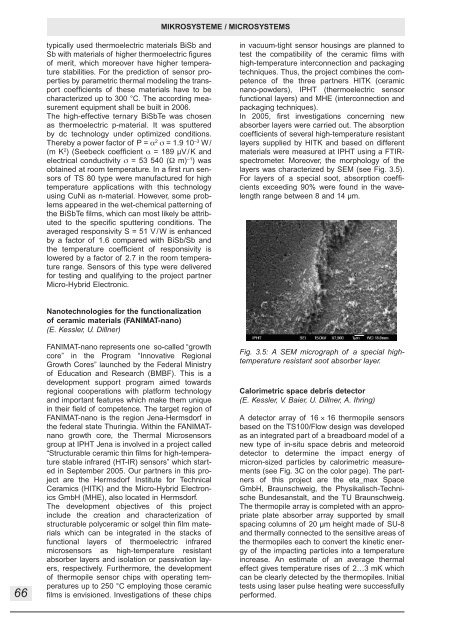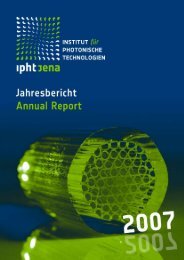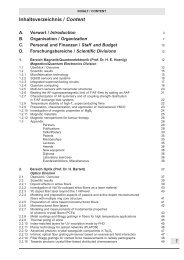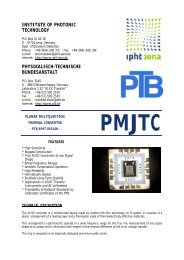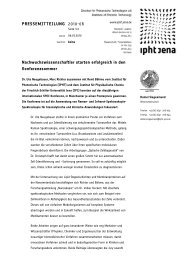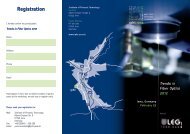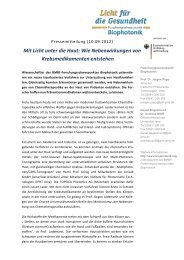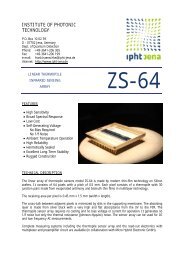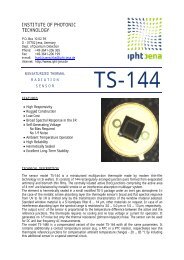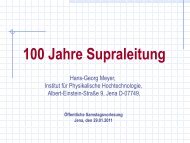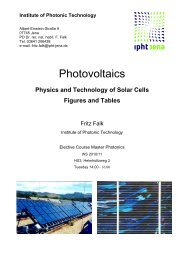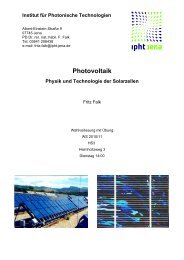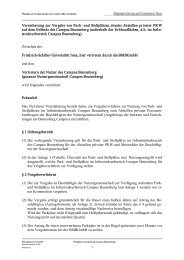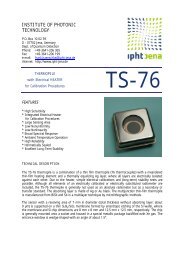Jahresbericht 2005 - IPHT Jena
Jahresbericht 2005 - IPHT Jena
Jahresbericht 2005 - IPHT Jena
You also want an ePaper? Increase the reach of your titles
YUMPU automatically turns print PDFs into web optimized ePapers that Google loves.
66<br />
typically used thermoelectric materials BiSb and<br />
Sb with materials of higher thermoelectric figures<br />
of merit, which moreover have higher temperature<br />
stabilities. For the prediction of sensor properties<br />
by parametric thermal modeling the transport<br />
coefficients of these materials have to be<br />
characterized up to 300 °C. The according measurement<br />
equipment shall be built in 2006.<br />
The high-effective ternary BiSbTe was chosen<br />
as thermoelectric p-material. It was sputtered<br />
by dc technology under optimized conditions.<br />
Thereby a power factor of P = α 2 σ = 1.9 10 –3 W/<br />
(m K 2 ) (Seebeck coefficient α = 189 µV/K and<br />
electrical conductivity σ = 53 540 (Ω m) –1 ) was<br />
obtained at room temperature. In a first run sensors<br />
of TS 80 type were manufactured for high<br />
temperature applications with this technology<br />
using CuNi as n-material. However, some problems<br />
appeared in the wet-chemical patterning of<br />
the BiSbTe films, which can most likely be attributed<br />
to the specific sputtering conditions. The<br />
averaged responsivity S = 51 V/W is enhanced<br />
by a factor of 1.6 compared with BiSb/Sb and<br />
the temperature coefficient of responsivity is<br />
lowered by a factor of 2.7 in the room temperature<br />
range. Sensors of this type were delivered<br />
for testing and qualifying to the project partner<br />
Micro-Hybrid Electronic.<br />
Nanotechnologies for the functionalization<br />
of ceramic materials (FANIMAT-nano)<br />
(E. Kessler, U. Dillner)<br />
FANIMAT-nano represents one so-called “growth<br />
core” in the Program “Innovative Regional<br />
Growth Cores” launched by the Federal Ministry<br />
of Education and Research (BMBF). This is a<br />
development support program aimed towards<br />
regional cooperations with platform technology<br />
and important features which make them unique<br />
in their field of competence. The target region of<br />
FANIMAT-nano is the region <strong>Jena</strong>-Hermsdorf in<br />
the federal state Thuringia. Within the FANIMATnano<br />
growth core, the Thermal Microsensors<br />
group at <strong>IPHT</strong> <strong>Jena</strong> is involved in a project called<br />
“Structurable ceramic thin films for high-temperature<br />
stable infrared (HT-IR) sensors” which started<br />
in September <strong>2005</strong>. Our partners in this project<br />
are the Hermsdorf Institute for Technical<br />
Ceramics (HITK) and the Micro-Hybrid Electronics<br />
GmbH (MHE), also located in Hermsdorf.<br />
The development objectives of this project<br />
include the creation and characterization of<br />
structurable polyceramic or solgel thin film materials<br />
which can be integrated in the stacks of<br />
functional layers of thermoelectric infrared<br />
microsensors as high-temperature resistant<br />
absorber layers and isolation or passivation layers,<br />
respectively. Furthermore, the development<br />
of thermopile sensor chips with operating temperatures<br />
up to 250 °C employing those ceramic<br />
films is envisioned. Investigations of these chips<br />
MIKROSYSTEME / MICROSYSTEMS<br />
in vacuum-tight sensor housings are planned to<br />
test the compatibility of the ceramic films with<br />
high-temperature interconnection and packaging<br />
techniques. Thus, the project combines the competence<br />
of the three partners HITK (ceramic<br />
nano-powders), <strong>IPHT</strong> (thermoelectric sensor<br />
functional layers) and MHE (interconnection and<br />
packaging techniques).<br />
In <strong>2005</strong>, first investigations concerning new<br />
absorber layers were carried out. The absorption<br />
coefficients of several high-temperature resistant<br />
layers supplied by HITK and based on different<br />
materials were measured at <strong>IPHT</strong> using a FTIRspectrometer.<br />
Moreover, the morphology of the<br />
layers was characterized by SEM (see Fig. 3.5).<br />
For layers of a special soot, absorption coefficients<br />
exceeding 90% were found in the wavelength<br />
range between 8 and 14 µm.<br />
Fig. 3.5: A SEM micrograph of a special hightemperature<br />
resistant soot absorber layer.<br />
Calorimetric space debris detector<br />
(E. Kessler, V. Baier, U. Dillner, A. Ihring)<br />
A detector array of 16 × 16 thermopile sensors<br />
based on the TS100/Flow design was developed<br />
as an integrated part of a breadboard model of a<br />
new type of in-situ space debris and meteoroid<br />
detector to determine the impact energy of<br />
micron-sized particles by calorimetric measurements<br />
(see Fig. 3C on the color page). The partners<br />
of this project are the eta_max Space<br />
GmbH, Braunschweig, the Physikalisch-Technische<br />
Bundesanstalt, and the TU Braunschweig.<br />
The thermopile array is completed with an appropriate<br />
plate absorber array supported by small<br />
spacing columns of 20 µm height made of SU-8<br />
and thermally connected to the sensitive areas of<br />
the thermopiles each to convert the kinetic energy<br />
of the impacting particles into a temperature<br />
increase. An estimate of an average thermal<br />
effect gives temperature rises of 2…3 mK which<br />
can be clearly detected by the thermopiles. Initial<br />
tests using laser pulse heating were successfully<br />
performed.


